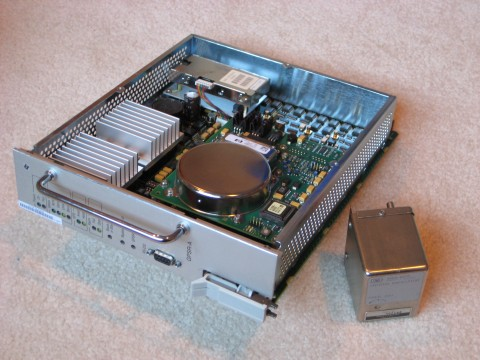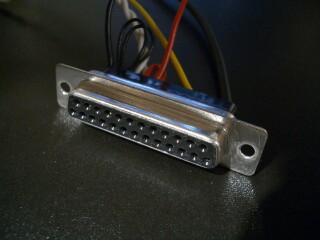© Brooke Clarke 2007
Background
These were used in the HP Z3815A which was a GPS disciplined oscillator used for cell phone timing (maybe in Australia).
Major ICs
U104, U105
U11
U200
Versions
The Z3815A GPS Time Frequency Reference GPSR-A VXI instrument like this one has a D connector on the bottom with sockets.
The E1938A puck on PCB as shown above (has a D connector on the top with pins.)
E1938-60201 is just the puck
Operation
-Rick-
Top and Bottom photos annotated with function of each pad or pin. E1938A_Pinout_Pictorial.pdf
Figure 2. D-sub with coax insert on circuit side of PCB.
Theory of Operation
Top Side Component Locator E1938asdrawa-8.pdf
GIF format schematics of the board and oscillator and layout drawings as E1938gifs.zip file.
pdf format schematic of the board and oscillator & layout drawings as E1938pdfdocs.zip
On the computerized data printout there is an item called
Hz off freq. after warm up:
This is a measure of how well the reasonating capacitor was selected by the factory to center 10 MHz in the EFC window.
Temperature Control
The 10811 has an ANALOG oven control loop. The gain is set to be just below the oscillation point. This is due to the stability limits dictated by the oven mass and (believe it or not) the size of integrator capacitor that can physically fit. If you want to "soup up" at 10811 oven, externally wire a larger capacitor in parallel and change the resistors to increase the gain. The 10811 designers did the best they could with what they had to work with, but you don't want to blindly copy them in new applications. BTW, do not use a "metalized" plastic integrator capacitor. Must be "foil" type.I am extremely happy with the PII^2D control loop on the E1938A (I didn't design it, only tested it). I can't imagine anything being better.
(referring to another temperature control system) The block cannot be well insulated because of the thermal overhead of the oven circuitry (the heat has to escape). I explained in my 1997 FCS paper how to achieve the isothermal condition, which is achieved by symmetry rather than high amounts of insulation. The E1938A oven works quite well if the insulation is omitted or replaced by poor insulation, except that it consumes more power.
Referring to vacuum oven: http://rfdesign.com/vlf_to_uhf/time_and_frequency/709RFDF1.pdf
At HP, in the 90's, we did a lot of brainstorming about vacuum ovens. This never seemed to make sense to us. If you actually achieve high amounts of thermal resistance, then you can't get the heat out of the oven. And if you don't, why bother with a vacuum. Also, a vacuum only helps if you do everything else you need to do to make a true Dewar (thermos bottle), like having mirrored surfaces, etc. Finally, having a vacuum means that nothing that outgasses can be used in the oscillator. Maybe Vectron has figured out something we didn't think of or has sufficiently difference constraints that a vacuum makes sense for them.
We went through this tradeoff on the E1938A. Resistive heaters can be distributed. However, it is very inefficient to drive them with transistors, because then you waste a lot of power heating the transistors, which is waste heat if resistive heating is used. Prior to the 10544, they just put up with this. The 10544 used a switching regulator for up the efficiency, but it put a 1 kHz spur on the oscillator. The 10811 used two transistors on opposite sides to try to sort of distribute the heat. On the E1938A, we looked at an array of small surface mount transistors to have the best of both worlds. However, this turned out not to be manufacturable and we settled for resistive heaters (back to 1970!).
-Rick-
Computer Program
Papers
The Theory Of Zero Gradient Crystal Ovens, R.K. Karlquist, L.S. Cutler, E.M. Ingman, J.L. Johnson, T. Parisek, HP & HP Labs, date?, publication?
A Low-Profile High-Performance Crystal Oscillator For Timekeeping Applications, R.K. Karlquist, L.S. Cutler, E.M. Ingman, J.L. Johnson, T. Parisek, HP & HP Labs, date?, publication?
Patents
Directly Related to the E1938
2163403 Stabilized Oscillator, Larned A. Meacham, assigned to Bell Telephone Labs, filed July 2, 1937, issued June 20, 1939., 331/139 ; 331/140; 331/183; 331/66; 333/17.1; 333/188 - uses light bulb to stabilize a crystal oscillator.
2268872 Variable Frequency Oscillation Generator, William R. Hewlett, assigned to H-P, , filed June 11, 1939, issued Jan 6, 1942, 331/141 ; 331/183 - this is the model 200A audio oscillator that got H-P started. - uses light bulb to stablize a bridge audio frequency oscillator. The frequency is controlled by an air variable capacitor which would not have any effect on conventional audio frequency oscillators.
The lamp thing is interesting because there is a lot of HP folklore that has grown up around the HP garage, the invention of the 200A oscillator, etc, and it seems that Bill Hewlett has gotten credit for the lamp stabilization idea. Possibly, he independently invented it, since he filed 6 months after Meacham did, but long before the Meacham patent was granted. Hewlett also copied or reinvented the idea of a bridge oscillator. His real contribution was to harness Meacham's previous technology to enable him to eliminate the inductor from the oscillator, which allowed him to raise the impedance level high enough to allow air variable capacitors to be used. It was a great design, whoever invented it.
(According to tradition, the model number 200 was used instead of 100 to give the impression that this wasn't the first HP product).
The original Hewlett patent is on display at Agilent headquarters where I work. I was kind of surprised that HP ("HP Invent") let Agilent have it. I am also pleased that in the HP Archives museum, on the first shelf, in the center, is a *working* 5071A. There is also, of course, a 200A oscillator on display.
The above are my own opinions and don't represent Agilent or HP.
Rick Karlquist
| 4155257 | May 1979 | Wittke |
| 4283691 | August 1981 | Burgoon |
| 4358742 | November 1982 | Ferriss |
| 4518930 | May 1985 | Rozema et al. |
| 4157466 | June 1979 | Herrin |
| 4216371 | August 1980 | Marotel |
| 4317985 | March 1982 | Wilson |
| 4396892 | August 1983 | Frerking et al. |
| 4839613 | June 1989 | Echols et al. |
| 5025228 | June 1991 | Gerard et al. |
| 5041800 | August 1991 | Long et al. |
Links
20-Sep-2003
Introduction
The HP E1938A is a very modern ovenized SC-cut quartz oscillator of radical design that had little or no product release due to project cancellation. As far as I know it was the first new oscillator designed by HP since the venerable 10811A. The performance of the E1938A is truly outstanding. I'm not sure which product it was intended for -- perhaps something Telecom or GPS related. HP sold that product line to Symmetricom in the late 1990's -- perhaps that had something to do with it.
Several years ago one of the developers of the oscillator graciously donated several surplus specimens for the museum which is how I was able to make this report.
Photos
This highly unusual oscillator has a pancake or hockey puck appearance. It looks like it would work in a 1U instrument. You can see several PIC microcontrollers on board.
| E1938A board with E1938-60201 ovenized oscillator assembly |
| For scale, the E1938A with a 10811A |
Power on
The E1938A requires +12 VDC at about 100 mA and +5 VDC at about 3 A at startup dropping to 1.5 A after a 10 minute warmup.
The output is 10 MHz. There is an EFC input but no manual fine or coarse frequency adjustment.
Here is a connection diagram:
| E1938A connector diagram |
Pin number Pin number Pin number of special of DB-25S of DA-15 on SUB-D: (equiv.): puck: Description: 1 1 10 ACOM/DCOM 2 2 2 VREF common 3 3 9 (indirect) EFC shield 4 4 none TX, serial port 5 5 none Data from PIC none 6 none not used none 7 none not used none 8 none not used 6 9 none Data to PIC 7 10 none PIC data ready 8 11 7 VREF, +2.5V 9 12 none 10 MHz. common 10 13 none 10 MHz. (signal) 11 14 10 ACOM/DCOM 12 15 10 ACOM/DCOM 13 16 1 (indirect) EFC+ 14 17 none +5V 15 18 none +5V none 19 none not used none 20 none not used 16 21 none RX, serial port 17 22 none +12V 18 23 none PIC clock 19 24 none not used 20 25 none not used shell shell shell ACOM/DCOM Signals on puck only: 1 RF/EFC+ 3 +4.5V 4 M/L heater 5 Heater return 6 Rim heater 8 Thermistor bridge 9 RF return/EFC- 11 Warmup heater 12 M/L htr sense 13 Heater rtn sense 14 Rim htr sense 15 Therm. bridge ref. shell ACOM/outer can (does not connect to puck) |
Connector
For those E1938A with a DB25P (male) connector on the top of the PCB you can make a matching connector using a DB25S such as this:
- black = ground connects to pins 1, 14, and 15
- white = a twisted pair (shorted) for EFC, pins 3 and 16
- red = +5V goes to pins 17 and 18
- yellow = +12V goes to pin 22
- RG174 coax with BNC = shield to pin 12 and signal to pin 13
Performance
The performance of this E1938A is ok but not stellar...
| Allan Deviation plot out to tau 10k seconds (S/N d11013) |
And another E1938A, with better performance, getting down in the 13's from tau 1 to 1000 seconds.
| Allan Deviation plot out to tau 10k seconds (S/N d11014) |
An example of frequency scale, ...
| Allan Deviation plot out to tau 10k seconds (S/N d11014) |























No comments:
Post a Comment